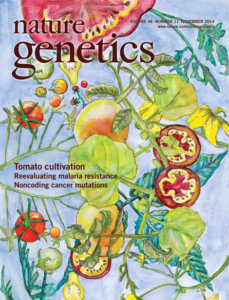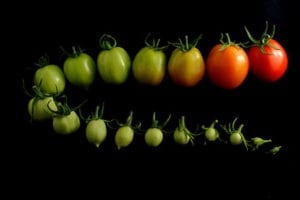News
Genomics Study of 360 Tomato Varieties Traces History, Points to Possible Improvements
In 2012, after a decade of work by a global consortium of scientists, the first tomato genome was sequenced. That genome—of the ketchup-worthy Heinz 1706 variety—has provided a group of 30 international scientists with a template for sequencing the genomes of 360 related wild, cultivated and modern hybrid tomato varieties. This recent study, whose results were published October 12, 2014 in the journal Nature Genetics, resembles a genetic archeological dig into the evolutionary history of the tomato, following traits through DNA to learn more about how humans have shaped it over time.
The study found that the process of domestication, cultivation and breeding of tomatoes by humans has resulted in a modern tomato with traits we care about most: large fruit size, red color and disease resistance. But this process also greatly reduced the amount of genetic variation in modern varieties. However, the study also pinpointed regions of the tomato genome where extra DNA has hitchhiked along with desirable DNA during breeding—regions breeders can now target for further crop improvement.
BTI scientists Jim Giovannoni and Zhangjun Fei were part of this study’s project team, each bringing extensive experience with large-scale genomics studies. We asked them to tell us more about the study, and explain how breeders can use the results to take today’s tomatoes to the next level:
More than 10,000 years ago, humans began domesticating wild plant species into cultivated crops. What did this study tell you about the domestication of tomatoes?
Giovannoni: Tomatoes have been domesticated for several thousand years; it’s hard to get exact dates on this. Their center of origin is the Andean region of South America, and the study showed that genes impacting fruit size were among the regions of the genome that was brought through early on in the domestication process. Early humans likely desired larger fruit and observed natural mutations; they kept seeds from these larger sized fruits. The likely ancestor of all red-fruited tomatoes is the tiny currant tomato (S. pimpinellifolium, the only red-fruited wild variety). From there, the data show that a two-step evolution in fruit size likely occurred, involving a number of additional independent genes. As a result, modern tomatoes can be at least 100 times larger than their wild ancestors.
It took a decade to sequence the first tomato genome. Just two years later, scientists have 360 more varieties sequenced. Why was there such a difference in effort and time between these two projects?
Fei: It is very difficult to build the first genetic sequence of a plant variety, what we call the reference genome. Think of it as a puzzle with millions of small pieces (genome fragments). We have to fit together the pieces to make a complete and accurate picture. Once you have identified the pieces and their positions, resequencing is much less expensive and labor intensive. Resequencing is a matching game: you take a new genome, match up, or align it, to the reference genome and analyze how it differs. Those differences helped us visualize how people have selected and bred tomatoes, changing their DNA over time.
This study resequenced and analyzed potentially 360 variants in each of the tomato genome’s 35,000 genes. That’s a lot of data. How did you manage it?
Fei: We generated 2.6 terabytes, or 2,600 gigabytes, of sequences. It took us several months to resequence the 360 genomes and then several more for analysis. Our role was data analysis and quality control, using existing tools and algorithms. In this type of work, it’s not about the technology; it’s about the quality of the data and the underlying interesting biology questions derived from that data.
The study found that the genes related to domestication and improvement of tomatoes occupy nearly 26 percent of the tomato genome, leaving limited bandwidth for further improvement using conventional breeding. How did this happen?
Giovannoni: In conventional breeding, you’re selecting for plants with certain desirable traits. If successful, you get offspring that display those traits, but these also carry extra DNA that might bring in traits you don’t want. So, you may select for Gene X, but will often actually get Gene X plus a big chunk of DNA on either side of Gene X. This results from genetic linkage. This linkage clogs the genome, reducing opportunities for breeders to bring in new genes. You can reduce linkage effects by exchanging and recombining DNA through multiple crosses. But breaking those linkages can be far more difficult when crossing varieties carrying traits from wild species, since they are much farther apart, genetically, from their cultivated cousins.
This sounds like bad news for breeders today who increasingly use wild species as a source of new genes, especially for disease resistance. Is there any good news here that could help breeders looking to wild genes for breeding breakthroughs?
Giovannoni: Yes! The good news is that the modern tomato genome has lots of room for improvement. The study found a lot of wild species DNA floating around in commercial varieties due to genetic linkage, and now that we know where these regions are, breeders can use molecular approaches to target them in a more refined way. They now become targets for additional selection and improvement, once breeders remove some of the extra DNA baggage that came along with, for example, the wild species disease-resistance genes.
Many people complain that grocery store tomatoes last longer, but are flavorless compared to their garden varieties. Can this study help breeders get back to a better-tasting commercial tomato?
Giovannoni: Post-World War II, there was a lot of breeding emphasis on field performance and yield, in addition to disease resistance. Today’s commercial varieties are a product of more recent breeding focused on good-looking tomatoes with long shelf-life: traits allowing them to survive the long supply chain common in the U.S. and Europe, where many tomatoes are grown in a few high production areas. Extending shelf life means delaying ripening—but also the associated development of higher quality flavors and aromas. Remedies to this poor quality are currently major focus areas of breeders and seed companies. For example, breeders might focus on the areas of excess wild species DNA we found, and perhaps bring them back to something closer to the cultivated tomato with a positive impact on quality. Also, as we learn more about the specific genes impacting quality, these additional tomato genomes may provide useful variants in important quality genes that can be bred into additional modern varieties for improved flavor.
What other traits do wild tomato ancestors have that breeders might want to reintroduce into modern plants and why?
Giovannoni: Wild plants have lots to offer. There are some really tough wild tomato species, growing in places with little water and extreme temperatures. Some species have traits like salt and other stress tolerances. If you can bring in traits like these, it could make a huge impact on meeting climate change challenges to global food production by opening new areas for cultivation and allowing growers to use fewer inputs. While this is mostly a question for staple crops like soy, corn, rice and wheat, it’s still very relevant for tomatoes.





